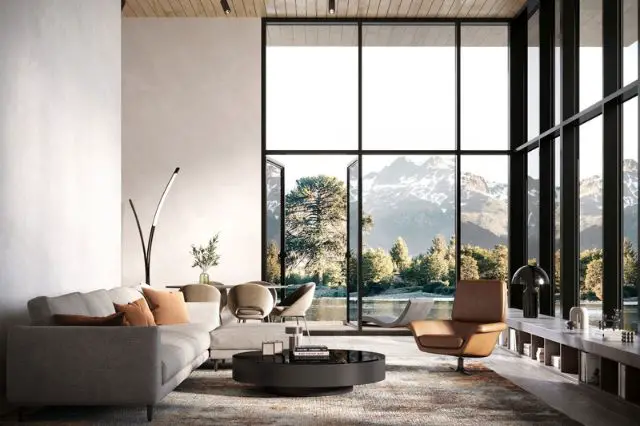3D modeling is a process of using specialized software to create a mathematical representation of any 3-dimensional object or environment. In 3D modeling, virtual objects are sculpted and crafted with computer-based tools, allowing for precise control over every aspect of the design.
For furniture in particular, 3D modeling has opened up endless possibilities for customization and innovation. Any piece of furniture can now be modeled digitally, with customized shapes, dimensions, materials, colors, and more. Designers have granular control when building 3D furniture models, right down to details like carvings, engravings, and textile patterns.
Once designed, 3D furniture models can be visualized and rendered with photorealistic quality. This allows designers to view and tweak their creations until the designs are perfected. The modeling process enables furniture to be customized precisely to an individual’s aesthetic preferences and functional needs. From conceptualization to final product, 3D modeling empowers designers to bring their wildest furniture visions to life.
Benefits of Using 3D Modeling for Furniture
Customization – One of the biggest advantages of 3D modeling for furniture is the unparalleled level of customization it enables. Every aspect of a furniture piece can be tailored, from the dimensions, shapes, colors, materials, and more. Want a curvy couch that fits perfectly in a rounded alcove? Or a bed with asymmetric headboard panels? With 3D furniture modeling, any form is achievable.
Visualization – 3D models allow designers to see their furniture creations on screen through photorealistic rendering. This makes it easy to visualize a piece in a real space and make tweaks to the design before physical production. Modifications are quick and inexpensive when done digitally.
Efficiency – The entire design and drafting process is significantly more efficient with 3D furniture modeling. All measurements and technical drawings are automatically generated from 3D models, streamlining furniture design. Revisions are also much faster digitally.
Cost-Effectiveness – 3D furniture modeling minimizes material expenses and costly design errors. Digital models allow for simulation tests and optimization, reducing material waste. Changes are inexpensive at the modeling stage. This saves money compared to traditional prototyping and revisions.
Creativity – 3D modeling enables designers to bring any furniture vision to reality. Without constraints on form or function, it opens up limitless creative possibilities. Designers can experiment with innovative shapes, textures, integrations, and moving parts that would be difficult or impossible to produce otherwise.
The benefits of 3D furniture modeling for industries
For furniture and manufacturers
3D modeling is a game-changer in design and production workflows:
– Faster design iterations – Designers can quickly model and visualize different styled furniture pieces in 3D, testing out generations of designs in a fraction of the time.
– Easier customization – With a 3D model, it becomes simple to tweak dimensions, shapes, textures, colors, and hardware based on customer specifications. This enables mass customization.
– Accurate renderings – Photorealistic 3D renderings allow furniture brands to showcase their products which is great for marketing.
– Optimized construction – 3D models provide comprehensive product specs that optimize construction, including material volumes, joinery details, assembly diagrams, and CNC machine coordinates.
Interior design firms
Interior designers use 3D modeling to create photorealistic renderings of client spaces with customized furniture:
– Realistic visualizations – Designers can create lifelike 3D renderings of client spaces fully furnished with customized pieces that match their vision.
– Easy modifications – Tweaking furnishings within a 3D model is much faster than redrawing plans. Designers can quickly make changes based on client feedback.
– Accurate measurements – Every dimension needed for furnishings is extracted from the 3D model automatically.
– Detailed specifications – 3D models contain all the specs needed to produce the designed custom pieces, like materials, finishes, upholstery etc.
For furniture retailers
Offering 3D furniture modeling services allows retailers to provide consumers with enhanced customization options:
– Custom configurators – Retailers can let shoppers customize product dimensions, materials, finishes, and more via interactive 3D configurators on their e-commerce platforms.
– Virtual showrooms – Using 3D modeling, retailers can create digital showrooms where shoppers can design their own personalized furniture.
– Accurate previews – Consumers can see photorealistic previews of what customized products will look like before ordering. This sets expectations accurately.
– Streamlined workflow – Once an order is placed, the retailer simply forwards the customer’s 3D model directly to manufacturers for production.
– Competitive edge – 3D customization services set furniture retailers apart from competitors while meeting demand for personalized products.
– Consumer excitement – The ability to co-design their pieces generates excitement among tech-savvy shoppers.
Conclusion
In summary, 3D furniture modeling provides huge opportunities for customization, efficiency, and innovation in the furniture industry. For designers, manufacturers, retailers, and consumers alike, embracing 3D furniture modeling unlocks a world of possibility.
With the ability to digitally craft furniture, the streamlined and optimized design process saves time, reduces overhead, and facilitates customization at scale. For consumers, 3D allows personalized furniture shopping experiences and products tailored to their lifestyles.
As the technology matures, 3D modeling will only become more accessible and integrated into furniture workflows. With its vast potential for customization, creativity, and cost-effectiveness throughout the furniture lifecycle, 3D modeling is undoubtedly the future of the industry.












